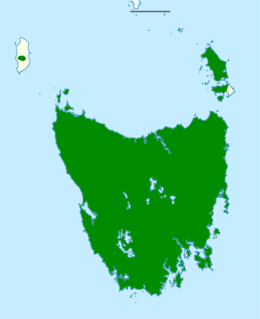Green rosella
| Green rosella | |
|---|---|
 |
|
| Female in Tasmania, Australia | |
| Scientific classification | |
| Kingdom: | Animalia |
| Phylum: | Chordata |
| Class: | Aves |
| Order: | Psittaciformes |
| Family: | Psittaculidae |
| Genus: | Platycercus |
| Species: | P. caledonicus |
| Binomial name | |
|
Platycercus caledonicus (Gmelin, 1788) |
|
 |
|
| Range (in green) in Tasmania | |
| Synonyms | |
|
Psittacus caledonicus Gmelin, 1788 |
|
Psittacus caledonicus Gmelin, 1788
Psittacus brownii Kuhl, 1820
Psittacus flaviventris Temminck, 1821
Platycercus xanthogaster Stephens, 1826
The green rosella or Tasmanian rosella (Platycercus caledonicus) is a species of parrot native to Tasmania and Bass Strait islands. It was described by the German naturalist Johann Friedrich Gmelin in 1788, and named on the mistaken assumption it came from New Caledonia. At 37 cm (14.5 in) long it is the largest species of the rosella genus, Platycercus. Two subspecies are recognised. The green rosella's underparts, neck and head are yellow, with a red band above the beak and violet-blue cheeks. The back is mostly black and green, and its long tail blue and green. The sexes have similar plumage, except the female has duller yellow plumage and more prominent red markings, as well as a smaller beak. Juvenile and immature birds have predominantly green plumage.
Found in a wide range of habitats with some form of tree cover, the green rosella is predominantly herbivorous, consuming seeds, berries, nuts and fruit, as well as flowers, but may also eat insect larvae and insects such as psyllids. Nesting takes place in tree hollows. Common and widespread across Tasmania, the green rosella is rated as least concern on the IUCN Red List of Endangered species. The King Island subspecies has been classed as vulnerable as its population has declined after much of its habitat on King Island was cleared.
A green rosella specimen was collected in Adventure Bay, Tasmania, by ships' surgeon William Anderson on the third voyage of James Cook between 26 and 30 January 1777. Cook wrote of seeing "yellowish paroquets" in the woods there. Tasked as the expedition's naturalist, Anderson collected many bird specimens but died of tuberculosis in 1778 before the return home. Many collection localities were incorrect, and notes were lost or pieced together many years later. The specimen, along with many others, ended up in the collection of British naturalist Sir Joseph Banks. English naturalist John Latham saw it there and wrote about the green rosella in his 1780s work A General Synopsis of Birds. He called it the Caledonian parrot as he assumed (incorrectly) it came from New Caledonia. He even suspected it might be the female of the horned parakeet, which he also saw in Banks' collection. Latham did not give them binomial names, however. It was left to German naturalist Johann Friedrich Gmelin to describe the species, which he did as Psittacus caledonicus in the 13th edition of Systema Naturae in 1788.
...
Wikipedia

